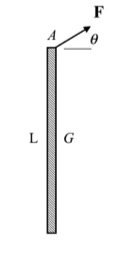| Problem statement Solution video |
DISCUSSION THREAD

NOTE: The view of the figure provided is that of the rod as seen from above the surface on which the rod lies.
Any questions?? Please ask/answer questions regarding this homework problem through the "Leave a Comment" link above.
Does a frictionless horizontal surface mean that it is on a horizontal plane?
Correct. This means that gravity does not need to be taken into account
Is there a normal force to account for in this question?
The only normal force would be opposing gravity, coming out of the page. Since this is in the horizontal plane we do not need to account for gravity and therefore we do not need to account for the normal force. The only force in your FBD should be force F
Would kinamatics be required for this question? If F is the only force acting on the rod I believe the question can be solved just through Newton/Eulers, would this be correct?
If in any kinetics problem in this course that you find that you do not need kinematics, then simply write: "Step 3: kinematics - NOT NEEDED.
In this problem, you do not need kinematics.
This is correct. You do not need kinematics in this problem since there isn't a problem where we have too many unknowns. The inertia is of the center of mass which is 1/12mL^2 based on the chart for inertia in our lecture book. Dividing F by g will give you your mass to solve a and b. Acceleration can be found by finding the force in the x and y directions and angular acceleration can be found by finding the torques that correspond to inertia times alpha.
MOI for a uniform rod around its center is 1/12 * m * L^2.
After solving for the acceleration of G, you will need to use M = IA (where I is moment of inertia and A is angular acceleration of the rod).
The mass is given in terms of pounds, which is mass*gravity. It's important to remember to divide this value by gravity in imperial units to find the mass alone when plugging into equations
Please note that the "weight" of the bar is given in terms of pounds.
I know that we need to use the M = IA Formula. However, I am confused on when we would use the (r cross ma) term if we are using the same equation and why it crosses out here.
For different problems, the 'r cross ma' term could be 'crossed out' for different reasons. Your goal should be to choose a point A such that this term goes to zero/ is 'crossed out'. In this problem specifically, if you choose the point A as the center of mass, then the position vector from A to G becomes a zero vector , and the whole cross product term goes to zero - simplifying our math.
I think it would be helpful to reference pg. 298 in the lecture book which explains it. This problem essentially falls into the first bullet point: by choosing the point of interest to be the center of mass, then the position vector is 0 and (r cross ma)=0. You would need to use the r cross ma when the point you choose is NOT
1) center of mass
2) fixed
3) with r(G/A) parallel to acceleration vector
All of the above cases have (r cross ma)=0, and we purposely choose a point such that we do not have to calculate r cross ma
When solving this hw, I did not need to use either accelerations to solve for each other. They were separate equations from the book. Similar to lecture
What helped solve this problem more easily is to remember that the Y component of the force being applied is cancels out when taking the moment around the center of mass.
The weight of the bar and the force acting on the bar are both given in lbs, so no unit conversion is necessary such as mg --> m
When dealing with a frictionless horizontal surface, we don't need to worry about gravity or its effect on the surface. We mainly focus on the force F acting on the rod, without considering motion equations. Remembering to use the moment of inertia formula M=IA is important, especially when figuring out how the rod rotates. Choosing A to be at the same location as the center of mass G, helps simplify calculations by eliminating unnecessary terms like r×ma. This method is all about making the math easier, as explained in the lectures.
In this problem, because the rod is in the horizontal plane and there is only one force, only kinetics are required to solve
You do not need kinematics in this problem since there isn't a problem where we have too many unknowns. The inertia is of the center of mass which is 1/12mL^2 based on the chart for inertia in our lecture book. Dividing F by g will give you your mass to solve a and b. Acceleration can be found by finding the force in the x and y directions and angular acceleration can be found by finding the torques that correspond to inertia times alpha.
When doing this problem, you will notice that you do not need to create any kinematic equations, you are able to solve with just kinetics. It is still important to realize that you need to use a moment equation about the center of gravity for this to occur.